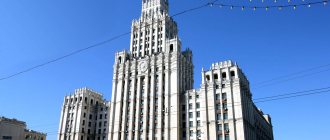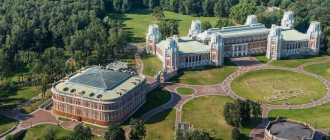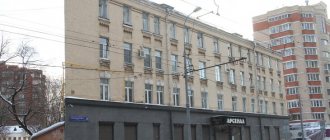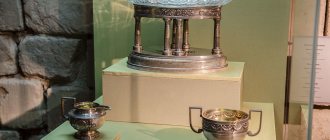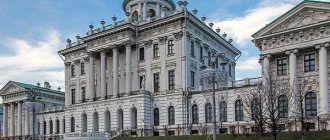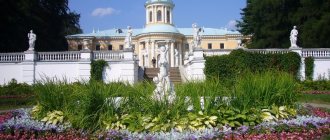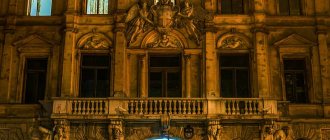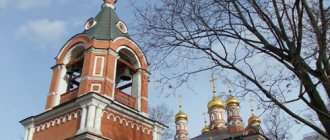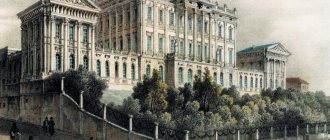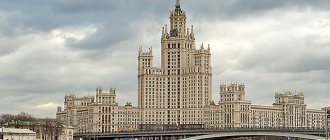Buturlins' residence
In the Vladimir region there is the village of Krutets, which is marked on maps of the country as a place with a rich history.
The mansion appeared on the site of an ancient monastery destroyed in the 12th century. Its owner, Ivan Buturlin, was well known in various circles, as he was one of the associates of Tsar Peter the Great. He helped the king fight for the throne with his cousin Sophia. When Peter formed his Preobrazhensky regiment, Buturlin was promoted to the rank of major, in which he participated in all military operations on land and at sea. In the battle of Narva he was unlucky and was captured. Subsequently, the tsar exchanged his major for General Meyerfeld.
After the death of Pyotr Alekseevich, Buturlin did not immediately take the side of Catherine the Great. He was influenced by Peter the Great's first assistant, Alexey Menshikov. A few years later, Ivan Buturlin took part in a conspiracy against Menshikov, which was uncovered, and as punishment he was deprived of all ranks and estates, except for one - the estate in the village of Krutets, where he ended his days.
In the mid-19th century, the new owners were the industrialists and merchants the Zubovs, who improved and slightly remodeled the mansion. Since then, its full name has been the Buturlin-Zubov estate.
Dilapidated multi-apartment family nest
17.06.2016
The Zubov House in Aleksandrov, where Emperor Alexander I stayed, is under threat of demolition
Evgenia Tvardovskaya
The Zubov house in Aleksandrov, Vladimir region, has in recent months acquired the dubious reputation of being the hero of scandals involving major repairs and resettlement of dilapidated housing. Behind the scenes remains its architectural and memorial value, two hundred years of venerable age and a fact that Alexandrov has always been proud of: it was in this house on Streletskaya embankment that Emperor Alexander I once stayed. The house is especially noted in the authoritative “Code of Architectural Monuments and Monumental Art”, in a volume on the Vladimir region, which is published by the Institute of Art History.
Today, a real threat of demolition hangs over the historical building. And local officials no longer hide the fact that there is no money in the budget for the resettlement of 31 apartments, but an investor can be interested. Here is a comment from the Commissioner for Human Rights in the Vladimir Region, Lyudmila Romanova: “Maybe we should attract some kind of investor-builder and give him this land for construction. There are options, they need to be worked out. In any case, this is the task of the municipal authorities.”
Preservation of a cultural heritage site does not appear among the authorities’ options and tasks. And quite justifiably - from a formal point of view. In 2008, the house received the status of an identified monument, but in April 2015, the regional Inspectorate for the Protection of Cultural Heritage refused to include it in the Unified State Register. Apparently, there was some kind of State Historical and Cultural Examination Act with the signatures of experts recognizing the building as having no value. Thus, the house of the early 19th century is today, in all respects, an ordinary dilapidated apartment building.
Of course, to say that it is well preserved means to sin against the truth. For the last hundred years it has not seen any repairs and has been maintained solely by the residents themselves. And the deterioration of its condition was facilitated by the dense development of the 1950-1960s near the house, in a low place near the Sulfur River. Without observing sanitary and construction standards, large structures were erected for warehouses of the Iskozh plant.
Courtyard of a house in the 1950s
The road between them and the house was paved, as a result the hydrogeology was disrupted, and water began to seep into the foundations and basements. The walls of the first floor became wet and became uninhabitable. The situation worsened year by year and in September 2015, the city prosecutor’s office even submitted a proposal to the head of the administration of the Alexandrovsky district to take specific measures to eliminate the identified violations of housing legislation to ensure safe living conditions in the “Zubov House”.
The epic with its poor condition and possible resettlement has been going on since 1985. And on April 22, 2021, the administration of the Alexandrovsky district issued Resolution No. 572 recognizing the house as unsafe and subject to demolition.
No home - no problem. No problems with possible heritage value, no problems with residents and their complaints.
It seems that only some of the inhabitants of this house, the old-timers, are the only ones in this whole story who are still fighting to preserve the demoted monument. They wrote to various authorities, including the ONF, drawing attention to the fact that the Zubov house cannot be treated as a dilapidated barracks, and that the demolition of such a monument threatens the loss of face for the city of Alexandrov.
However, from the point of view of the administration, such a house is cheaper and easier to demolish, and since the demolition of the monument is impossible, it was deprived of its status. For such cases, when, in fact, emergency housing is a monument, or “overhaul” is required for a cultural heritage site, apparently, a special procedure should be provided for in the Housing Code, taking into account 73-FZ. In the meantime, there are no such standards - valuable historical buildings are proceeding according to the usual “stage”.
Of course, the Alexandrov administration still has a choice: try to find financing and save the house. But all the actions taken and described above by the city authorities do not indicate good intentions. The situation with the house is brought to an extreme and life-threatening: in such circumstances the choice - in the eyes of public opinion - is small. Moreover, city officials already have experience of “decisive action” in relation to monuments. A striking example is another house of the glorious Zubov family - the Assembly of the Nobility, which was reduced to semi-ruin by the city administration.
After the fire that happened at the very end of 2015, officials found nothing better than to simply, without any projects or approvals, partially dismantle the building. Representatives of the regional state body for the protection of monuments - the State Inspectorate for the Protection of Cultural Heritage Objects of the Vladimir Region - have already stated publicly that this is “pure destruction of the monument” and “the Alexander administration grossly fails to comply with the requirements of the law.”
Dossier.
Zubov House in Alexandrov
The historical “Zubov House” is located in the central zone of the city of Alexandrov on a corner plot at the intersection of Kirzhachskaya Street and Streletskaya Embankment. The surviving brick two-story plastered house is based on a building from the early 19th century. The house was purchased in 1820 for his sons Stepan and Mikhail by a representative of a prominent merchant family, merchant of the second guild Ivan Ivanovich Zubov (1763-1828). Nearby on the banks of the Sera River in the 1820s I.I. Zubov and his sons began construction of the Zubov textile factory. The will mentions a stone house “on two floors” in the settlement “Strelikha near the Kirzhach road.”
The house was considered the best in the city, it is no coincidence that Emperor Alexander I stayed here in 1823. “...on the 24th of this month (August) at 4 o’clock in the afternoon, Emperor Alexander Pavlovich deigned to pass from Yaroslavl through Alexandrov, the apartment was owned by the 2nd guild of the merchant Stepan Zubov, on this date I deigned to leave through Kirzhach to Moscow,” wrote S.I. Zubov in his “Mesyatseslov”.
From the family chronicle of V.P. Zubov and articles by historian Stromilov, you can learn about the details of this historical event for the city of Alexandrov. After visiting the Assumption Monastery, “having listened to the mayor’s report and honoring with a gracious bow the petition of the city society in the person of its mayor and elected officials,” the emperor “hurried to rest ... in the chambers of the house of the merchant brothers S.I. and M.I. Zubov..." “The continuous “hurray” of the worried mass of people surrounding the house was encouraged by the repeated appearance in the open window of the open and kind face of the Emperor... the sovereign honored with a reception representatives of local authorities, the nobility and merchants and, having refreshed himself with a lunch and breakfast prepared for him and his retinue in those chambers , had tea..." Thanking the representatives of the city and the owners of the house that served him, S.I. and M.I. Zubov for the warm welcome “... in memory of this he granted the daughter-in-law of the first and the wife of the second each a ring decorated with precious stones.”
At the end of the 19th century, the heir to the Zubov enterprise and residential estate, Pavel Vasilyevich Zubov (1862-1921), a versatile educated and gifted person, a chemist, musician and collector, who by that time was constantly living in Moscow, sold the textile factory in Aleksandrov, but left it behind is a family house on Strelikha. The family continued to live in this house and in the Krutets country estate in the summer.
Pavel and Natalya Zubov
In this house at P.V. Zubov and his wife Natalya Mitrofanovna (née Gracheva) were born Vasily Pavlovich Zubov (1900-1963), who later became an outstanding philosopher and historian of art, religion and science.
Vasily Pavlovich Zubov
In the memoirs of N.M. Zubova has preserved a description of this part of the city and the estate at the turn of the 19th-20th centuries, when the Zubovs lived “... in an old white big house, with a large yard overgrown with grass. In addition to the house, in this yard there were also a stable, sheds, a kitchen, a laundry room and a two-story outbuilding, which in ancient times was called a “conservatory”. On one side of the house there was a small garden in which tall ancient trees grew, beautiful spruce trees looking into the front rooms, there was a swimming pool and a flower bed with colorful flowers. ...We drank tea on the lower floors, in low basement, but cozy rooms, and went for a walk, mostly to Valovnya, that was the name of a small elevated space, something like a plateau, not far from our house ... from here there was a beautiful view of the city of Alexandrov,” etc. .d.In Soviet times, the house was built on a third floor and extended with an equally high building to the west, along Streletskaya Embankment. The interior layout of the main old part has been changed.
The Zubov House is a rare example for Alexandrov of a wealthy merchant house of the early 19th century, which, despite the reconstruction, retained the original structure of impressive facades in classic forms. The volume of the old house (the eastern part of the existing building) is a large rectangular two-story building, elongated in the north-south direction. The main extended eastern facade, with 13 axes of openings, as well as the end southern and northern street facades, retained the basis of the original composition. The main expressive elements of the facade are the evenly spaced deep niches (with three-center gently sloping arched lintels), in which the rectangular windows of the upper floor are placed. The decoration of the facades is complemented by blades located on the walls between the niches. In addition to its architectural significance, the building has outstanding historical and memorial value.
(Based on materials from the “Code of architectural monuments and monumental art of Russia. Vladimir region. Part I. Moscow, “Science”, 2004. pp. 533-535).
Inhabitants of the Zubov house in the city of Alexandrov
(Certificate from M.V. Zubova)
Vasily Pavlovich Zubov (1835-1889) belonged to the old merchant family of the Zubovs, which for three centuries, starting from the end of the 17th century, played a prominent role in the history of the city of Alexandrov. His grandfather, Stepan Ivanovich, founded a dyeing and printing factory in Alexandrov, and also, together with I.F. Baranov, built a factory on the lands of the village of Karabanovo, which later became known as the Troitsko-Alexandrovskaya manufactory. In 1823, the Zubovs received Emperor Alexander I in their home.
Vasily Pavlovich inherited a dyeing factory from his father and successfully managed production. In addition, he was involved in public affairs of the city. During the construction of the railway through Aleksandrov, he was at the post of City Mayor, therefore he took an active part, together with other Aleksandrovsky industrialists and merchants, in the construction of the railway to Yaroslavl through Aleksandrov. They managed to convince Emperor Alexander II to change the original plan - to build this road through Pereslavl-Zalessky. The Alexander merchants donated 100 thousand rubles for the implementation of this project.
The Zubov family continued the good traditions of charity. They donated a lot to monasteries, churches, schools, orphanages, hospitals and almshouses. In 1869, Vasily Pavlovich donated 6 thousand rubles for the renovation of the Church of the Assumption of the Convent in Alexandrov.
Vasily Pavlovich had a good education and was well versed in literature and music. V.P. Zubov collected a wonderful collection of bowed instruments - Amati, Stradivarius, Guarneri violins and Ruggeri viola. In 1882-1883, Vasily Pavlovich was elected director of the Imperial Russian Musical Society. Unique instruments from the collection of Vasily Pavlovich are now stored in the Museum of Musical Culture named after M.I. Glinka.
For 33 years until his death in 1889, Vasily Pavlovich headed the industrial production of Aleksandrovsky district. It so happened that he became practically the last manufacturer from the Zubov family. His son Pavel, having defended his PhD thesis in chemistry, came to Alexandrov to study dyeing, but realized that production management was not his calling. After the death of his father, Pavel Vasilyevich sells the factory in order to devote himself to science, music and the main work of his life - numismatics. After the Zubovs, the factory changed hands several times. During the Soviet period, it became one of the leading industrial enterprises of Alexandrov - the Iskozh plant.
In Aleksandrov, in the family home, the grandson of Vasily Pavlovich Sr. was born, his full namesake Vasily Pavlovich Zubov (1900 - 1963) - philosopher, historian of science and architecture, world-famous scientist, author of many monographs and articles. Since 2000, “Zubov Readings” have been held in Alexandrov. In 1970, a memorial plaque was installed at the Zubov House in Moscow with the inscription: “Prominent figures of Russian science and culture Pavel Vasilievich and Vasily Pavlovich Zubov lived and worked in this house.”
In 1997, a memorial plaque was installed in the lobby of the State Historical Museum: “Donors, patrons and patrons” on which the name of Pavel Vasilyevich Zubov is written.
History of the Moscow estate
In the very center of Moscow, approximately at an equal distance from the Marxistskaya and Taganskaya metro stations, in a cozy corner on Solzhenitsyn Street, the Zubov estate is located.
The building, magnificent for those times, was built by the Zaitsev merchants, who subsequently sold the house to the merchant, a representative of the first trade guild, Alexei Mikhailovich Polezhaev, who was an honorary resident of the city. After some time, his daughter married a representative of the merchant family Vasily Zubov. The young family began to live in the estate, where their son Pavel later appeared, who glorified his family and family in the field of chemistry.
He was also a famous musician and numismatist. He took an active part in charity. His son, Vasily Pavlovich, also became a famous scientist in the field of history and philosophy. He lived all his life with his family in the Zubov estate, which is also called the Polezhaev-Zubov estate, since the building never passed into the wrong hands and remained the family residence.
City estate of A.V. Polezhaeva - Zubovs
- Add a photo
- Add an article
- Add a comment
11/18/19/Added by the editors/
- Show object on map
- Show similar properties
- Other names: House of Zubovs
- Date of construction: XVIII-XIX centuries.
- Address: Alexandra Solzhenitsyn st., no. 9, building 1
- Coordinates: 37°39′24.57″E; 55°44′33.56″N
Print information about an object
A beautiful old mansion on A. Solzhenitsyn Street (formerly Bolshaya Alekseevskaya and Bolshaya Kommunisticheskaya) once belonged to the hereditary honorary citizen Alexei Mikhailovich Polezhaev. In 1851, he bought the estate along with a stone house from the merchant Zaitsev and rebuilt the mansion, decorating it with the monogram “AP” with two angels akimbo, which has survived to this day.
Polezhaev's daughter Klavdiya Alekseevna married Vasily Pavlovich Zubov, a merchant of the first guild and a passionate collector of rare musical instruments, who collected a valuable collection of bowed instruments by Stradivari, Guarneri, Ruggeri and Amati. Subsequently, the collection passed to the Zubovs’ son, Pavel Vasilyevich, a hereditary honorary citizen, thermochemical scientist, bibliophile and philanthropist. He also became the last owner of the mansion.
In 1919, the Zubov mansion received the status of a branch of the State Historical Museum, and Pavel Vasilyevich was appointed custodian of his collection of coins and library of oriental studies. That same year, the collection of musical instruments was confiscated. On its basis, a state collection of unique instruments was created, which is now stored in the All-Russian Museum Association of Musical Culture named after M. I. Glinka. After the death of Pavel Vasilyevich in 1921, his son, Vasily Pavlovich Zubov, a philosopher, historian of science and art, was appointed curator of his father’s collection and library as assistant curator of the Numismatic Department of the Historical Museum. In 1923, the collection was transferred to the Moscow Historical Museum, where it is currently located.
During the Soviet years, part of the house was occupied by the district “Teacher’s House” (later – “House of Education”), and part of the building remained residential - Pavel Vasilyevich’s son Vasily Pavlovich lived here. In the 1970s, a plaque was installed on the Zubov house with the inscription: “Prominent figures of Russian science and culture Pavel Vasilyevich and Vasily Pavlovich Zubov lived and worked in this house.”
In 2004, the mansion was purchased by the Sokolov family, and in 2011, the scientific restoration of the estate was completed. Currently, the house still hosts concerts, as well as excursions, international exhibitions and meetings. The mansion houses a gallery of modern sculpture.
Book a tour of this site
I have not been hereI have been hereMy notes on visiting this site
Add to visit planAdded to visit planMy visit plan
Modern use of the manor
In 2004, the old mansion building was acquired by the Sokolov family. They restored the Zubov estate, returning the historical appearance even to the unique stucco on the ceilings. The restoration was completed only in 2011, and since then the doors of the amazing house have been open to everyone. Excursions began to be held here, which are enjoyed by not only domestic but also foreign tourists. A magnificent concert venue was organized. The Zubov estate on Taganka gives academic concerts during the theater season. Russian and foreign orchestras perform here, and vocalists come with their programs. In autumn and winter, literary evenings and meetings with artists are held.
Gallery and museum
The Zubov estate has a unique gallery, which is located in the oldest part of the house, on the ground floor. Under the brick vaults there are four galleries where exhibitions of sculptural works are collected. The gallery has a separate entrance, not connected to the main one.
On the top floor there is a museum, which contains not only personal items of the former owners, but also musical instruments, furniture and books.
